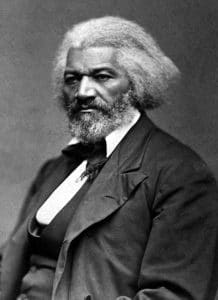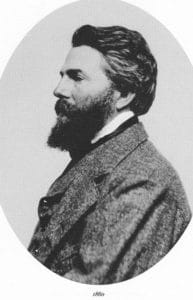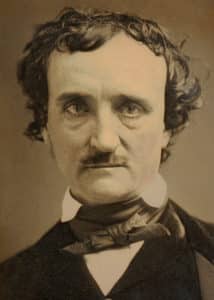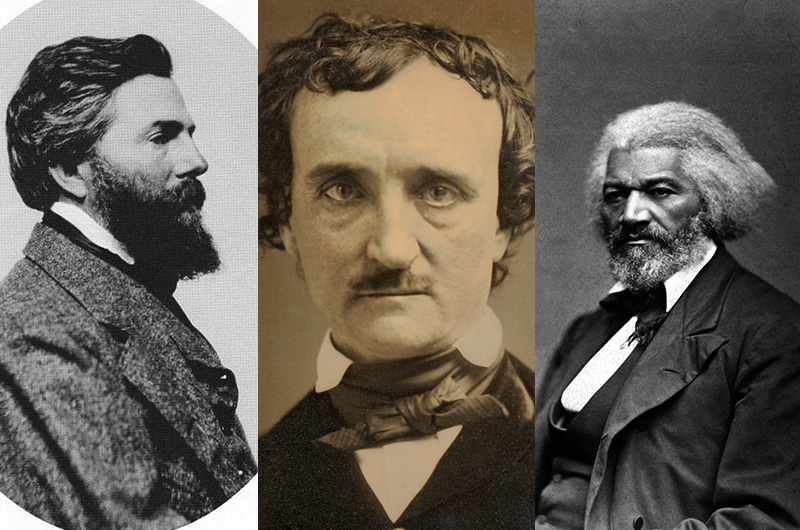~ by Amy Jenness ~
More than 100 years after the first white people settled on Nantucket, the French-American writer Hector St. John de Crevecoer visited and recorded his perceptions of island life in his influential book Letters From An American Farmer. Published in 1782, the book was the first European bestseller written by an American and featured the first example of an author attempting to define what it means to be an American.
De Crevecoer divided the book into “letters” and wrote it in an unusual structure that still has historians debating whether it is a novel or a memoir. When de Crevecoer writes about Nantucket in five “letters” he adopts the tone of a travelogue full of newsy narrative that reflected his admiration for the island, which was thriving as the capital of whaling at the time of his visit.
Who would have imagined that any people should have abandoned a fruitful and extensive continent, filled with the riches which the most ample vegetation affords; replete with good soil, enamelled meadows, rich pastures, every kind of timber, and with all other materials necessary to render life happy and comfortable: to come and inhabit a little sandbank, to which nature had refused those advantages; to dwell on a spot where there scarcely grew a shrub to announce, by the budding of its leaves, the arrival of the spring, and to warn by their fall the proximity of winter…Had this island been contiguous to the shores of some ancient monarchy, it would only have been occupied by a few wretched fishermen, who, oppressed by poverty, would hardly have been able to purchase or build little fishing barks; always dreading the weight of taxes, or the servitude of men− of−war.

De Crevecoer would be by no means be the only popular writer to feature Nantucket. For centuries writers have been fascinated by “customs at Nantucket,” as de Crevecoer called island life. Frederick Douglass, a runaway slave famous as a writer and speaker in the mid to late 19th Century, wrote about his first visit to Nantucket, the place where he made his first public speech in 1841. His anti-slavery treatise, Narrative of the Life of Frederick Douglass, An American Slave, published in 1845, solidified Douglass’ role as an important voice in the abolitionist movement and had sold 30,000 copies by 1860.
Famous for his macabre short stories, the only novel ever written by Edgar Allen Poe was The Narrative of Arthur Gordon Pym of Nantucket, in 1838. A young Pym stows away aboard the Nantucket whaleship Grampus and has many adventures that include a shipwreck, mutiny and cannibalism. Reviewers were not kind, the book did not sell and its failure marked a turning point in Poe’s career. He went to work as a magazine editor and began to focus on writing the short stories he would later become known for. But his one novel did have a strong influence on the writers Jules Verne and Herman Melville. And, scholars note many similarities between Poe’s and Melville’s work.

Melville was a crewmember on two Nantucket-owned whaleships in his youth, but never visited the island when he wrote his novel of the sea Moby- Dick, published in 1851. Yet, he situated the doomed crew on a Nantucket ship called the Pequod under the leadership of Nantucket Quakers. Melville devoted Chapter 14, aptly named “Nantucket,” to describing the island and its characters. He wrote at length about the island’s remote location, flatness, lack of vegetation, extreme amount of sand and concluded, “Nantucket is no Illinois.” One year after Moby-Dick’s publication Melville visited the island for the only time. He travelled with his father-in-law, stayed one night and met astronomer Maria Mitchell and surviving Essex whaleship captain George Pollard.
Lillian and Frank Gilbreth brought their large family to Nantucket every summer and lived in a Brant Point cottage made by joining two lighthouses together. The Gilbreth’s, who worked as efficiency experts, had 12 children. Their hectic life was chronicled by two of their children in the popular book and film Cheaper By The Dozen, published in 1948. In 1949, a camera crew from 20th Century Fox arrived on island to capture scenes for film version. Nantucket youth were shot playing baseball and tennis dressed in the styles of the 1920s. An updated version of the film was released in 2003. Robert Benchley, famous as a writer, humorist and filmmaker in the 1930s and 1940s, began summering with his family on the island’s east end in ‘Sconset. Benchley’s son, Nathaniel, captured Nantucket’s quirky characters in his novel The Off-Islanders, which was adapted for film as the popular “The Russians Are Coming, The Russians Are Coming!” And Nathaniel’s son, Peter Benchley, wrote the blockbuster book Jaws in 1975, which was also adapted for film.

Although they never wrote a story set on Nantucket, two American literature giants – Ernest Hemingway and John Steinbeck – both spent time on the island. In 1910 Hemingway visited for a month with his mother Grace when he was 11 years old. Mother and son stayed in a guest house on India Street and Ernest, born and raised in the midwest, learned about whaling and swam in the ocean for the first time during is Nantucket visit.
In 1951 writer John Steinbeck and his family rented a house in ‘Sconset owned by Peter Benchley. Steinbeck liked it the island and his writing profited. “I never knew a place with more energy than here,” he wrote in a letter to a friend. In the morning Steinbeck worked on his book East of Eden and went swimming or fishing in the afternoon with his family.
Noted writers who more recently have called Nantucket home include journalist David Halberstam, New York Times columnist Russell Baker, diarist and composer Ned Rorem, historian Nathaniel Philbrick and novelists Nancy Thayer and Elin Hilderbrand.
Amy Jenness is author of On This Day in Nantucket History.



